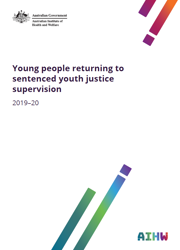Summary
This report measures the number of young people who were released from a supervised youth justice sentence and who were subsequently returned—that is, young people who received another supervised sentence after the end of their initial sentence. Supervised sentences include both community-based and detention sentences.
Birth cohort: key findings
The birth cohort analysis examines rate of return following the first supervised sentence, for young people who were born between 1990–91 and 2001–02, using their entire youth justice supervision history when they were aged 10–17.
The majority of young people do not return to sentenced supervision
Three in five (59%) young people who were under sentenced youth justice supervision at some time between 2000–01 and 2019–20 did not return to sentenced youth justice supervision.
Young people with an initial sentence of detention were more likely to receive an additional supervised sentence (51%) than people with an initial community-based supervised sentence (41%).
Of the young people aged 10–17 who were under sentenced youth justice supervision between 2000–01 and 2019–20:
- among those with an initial supervised community-based sentence, young people aged 10–12 at first sentenced supervision had the highest return rate (90%) of all age groups. The return rate declined with each successive age group
- males were more likely than females to receive an additional supervised sentence before the age of 18 (43% and 35%, respectively)
- Aboriginal and Torres Strait Islander young people were more likely than non-Indigenous Australians to receive an additional supervised sentence before age 18 (55% and 34%, respectively).
Supervision cohort: key findings
The supervision cohort analysis examines the rate of return for young people who were released from a supervised sentence during 2018–19, and whose age made them eligible to return to youth justice supervision within 1 year (aged 10–16 at the time of release). It includes young people who were released from their first ever supervised sentence, and those who had already had a prior episode of sentenced supervision.
Young people released from sentenced detention are more likely to return to sentenced supervision within 6 and 12 months
Of the young people aged 10–16 who were released from sentenced supervision in 2018–19 (allowing a 12‑month follow-up period to 30 June 2020):
- more than one-third (38%) who were released from sentenced community-based supervision received a subsequent supervised sentence within 6 months, and more than half (54%) within 12 months
- about 3 in 5 (61%) who were released from sentenced detention received a subsequent supervised sentence within 6 months, and 4 in 5 (80%) within 12 months
- young people with at least one previous sentence were more likely than those with no previous supervised sentence to be returned to sentenced supervision. This finding was across supervision types (community-based vs detention) and time to return (6 months vs 12 months).
Over the 10 years to 2018–19, the 6 and 12 month return rates for young people released from community-based supervision fluctuated. For those released from detention, the return rate within 6 months fluctuated over the period, while the return rate within 12 months remained relatively stable since 2012–13.
Summary
1. Introduction
- Key concepts
2. Returns to sentenced youth justice supervision while aged 10–17
- Demographics
- Length of first supervised sentence
- Time to return
- Total number of supervised sentences
- States and territories
3. Returns to sentenced youth justice supervision within 6 and 12 months
- Trends
- Demographics
- Previously sentenced to supervision
- Length of index sentence
- Returned with a sentence of detention
- States and territories
Appendix: Data and methods
End matter: Data sources; Linkage method; Analysis data sets; Acknowledgments; Glossary; References



